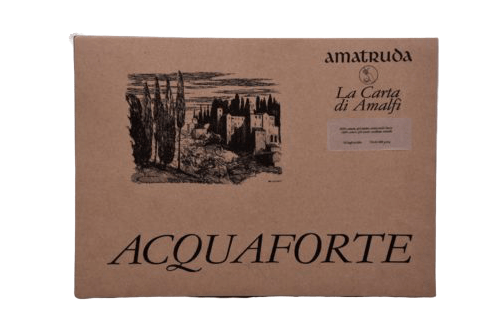Etching Technique 12 February 2021 – Posted in: News – Tags: amalfi paper, COPPER ENGRAVINGS, Etching
Engraving plays a special role in the evolution of art history and the community, being itself strongly connected to the invention of modern printing.
With the term etching, we mean a particular process of engraving, on plates of various metals (copper, zinc) covered by a layer of wax, achieved by the action of nitric acid in correspondence of the signs hollowed in the coverage on the latter surface.
For this technique is generally preferred to use copper plates, but it is also commonly used to make it on zinc plates that are less unalterable during the reproduction in print.
How to clean the plates
The metal plate for etching should generally be 1-2 mm thick. The plate is cleaned with white spirit or chloroform and then rubbed with chalk powder.
To check that the plate is perfectly clean, it is placed horizontally and covered with water. If the sheet is perfectly covered, cleaning is complete. At this point the sheet is ready to be surface treated with an acid-resistant black paint.
When the layer of paint has completely solidified, you can start engraving the design using steel tips.
The drawing

When marking the parts that will be darkened during the printing process, it will be necessary to take into consideration the widening of the traces due to the action of the acid; the advice is to make the grooves keeping a prudent distance and without pressing too hard on the paint.
In this part of the Etching process, one of the difficulties you may encounter and to consider, is drawing the subject upside down. At this point it will seem impossible and you will be about to give up on your project but…don’t give up! With a few little tricks we can certainly prevail in this challenge!
In fact, all you have to do is sketch out your drawing in pencil or ink and engrave it by copying the draft through a mirror. This will help you follow the lines symmetrically and correctly for printing.
Another trick, which many of you have used since you were children, is to put the drawing against the light and …. the rest comes by itself 🙂
The engraving
If you’ve made it this far, it means you’re ready for engraving.
In a basin we pour the citric acid or any other liquid mordant for the height of about 1cm, so you can see clearly through the effect you are getting on the metal plate without the need to lift it repeatedly and be able to intervene with the steel tips for some small measure even during this phase.
As you will see, the mordant will act on the metal that we have freed from the wax, leaving the rest of the protected sheet intact. The depth of the engraving will be determined by the time we leave the plate in the mordant and its aggressive power. The more strokes are engraved, the darker and more marked the lines will be during printing.
To avoid engravings with too uniform linearity, besides using steel tips of different sizes, it is a good idea to remove the plate from the clamping bath from time to time and cover the parts already sufficiently engraved with an alcohol varnish, thus creating signs of different intensity and chiaroscuro effects that will give three-dimensionality during printing, this development is technically called “clamping for covers”.
The ink
This work can be defined as finished depending on the sensitivity of the artist who considers each time if the engraving has the right characteristics desired.
Having made his assessments, the engraver can continue with the cleaning of the plates, which can be done with petroleum, white spirit or gasoline, and proceed with inking by passing over the plate with a pad or roller impregnated with printing ink. Once the excess dye has been removed, the ink will stop in the notches and appear on the shiny bottom of the plate, which will be passed through the press to have the engraving printed on a special etching paper previously wet to make it soft and absorbent.
That’s all for today, we look forward to seeing you on the pages of our blog and our website www.lacartadiamalfi.it for all the latest news and practical tips to follow 🙂
See you soon!
This post is also available in: Italian
